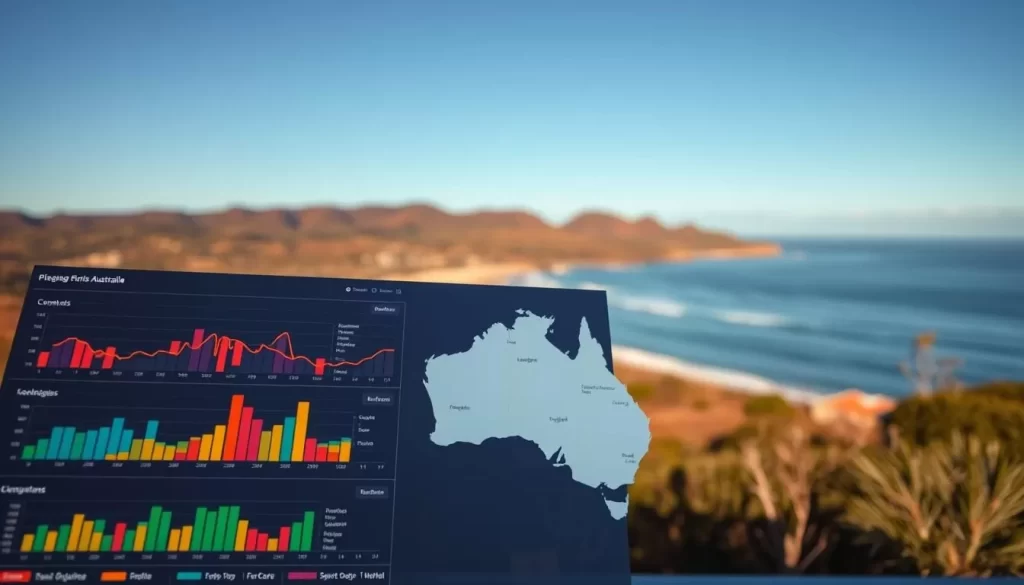Queensland is a vibrant region known for its cultural and linguistic diversity. While English serves as the primary language, the area is home to a rich tapestry of other languages. According to the 2021 census, 72% of the population speaks only English at home, while 22.8% use another language.
Indigenous languages also play a significant role. Over 120 Indigenous languages are still in use today, with Yumplatok and Kriol being among the most spoken. This reflects the deep cultural heritage of the region.
Immigrant communities contribute to this diversity as well. Languages like Mandarin, Arabic, and Vietnamese are increasingly common, showcasing the impact of migration over time. This article explores how these languages shape Queensland’s identity and community life.
Introduction to Queensland’s Linguistic Diversity
Over the years, this region has seen a remarkable shift in its linguistic landscape. The 2021 census reveals that more than 300 languages are spoken here, reflecting a rich cultural tapestry. This diversity is not just a statistic but a living, breathing part of everyday life.

Overview of Census Data and Community Insight
Comparing census data from 2006 to 2021 shows significant changes. In 2006, 72% of the population spoke only English at home. By 2021, this number dropped to 68%, indicating a rise in non-English language speakers. This trend highlights the growing influence of migrant communities.
Community insights further enrich this picture. For example, 22.7% of the population was born overseas in 2021, up from 12.3% in 1971. This increase has brought languages like Mandarin, Arabic, and Vietnamese into the mainstream, shaping the region’s identity.
| Year | English Speakers at Home (%) | Non-English Speakers at Home (%) |
|---|---|---|
| 2006 | 72 | 28 |
| 2021 | 68 | 32 |
Societal changes, migration, and policy adjustments have all played a role. For instance, the Multicultural Policy introduced in 2004 has helped integrate diverse communities. This policy ensures equitable access to services, regardless of cultural or linguistic background.
Understanding these trends is crucial for planning resources and services. The datum from census reports not only informs current language trends but also helps address community needs. In the following sections, we’ll explore specific languages and their impact in greater detail.
Queensland, Australia: Official and widely spoken languages
The linguistic landscape of this region reflects a blend of tradition and modernity. While English remains the dominant language, its role is complemented by a growing diversity of other languages. According to the 2021 census, 72% of the population speaks only English at home, while 22.8% use another language.

English: The De Facto National Language
English serves as the primary language for communication, education, and governance. It’s the most widely spoken language, with 81.2% of people using it at home. This dominance reflects its historical and cultural significance.
Despite its prevalence, the english language coexists with a rich tapestry of other languages. This balance highlights the region’s multicultural identity.
Growth of Non-English Language Communities
Non-English language communities are expanding rapidly. For example, Mandarin speakers have increased significantly, now representing 2.5% of the population. This growth is driven by migration and cultural exchange.
Other languages like Arabic and Vietnamese are also on the rise. These trends underscore the evolving linguistic diversity of the region.
Community insights reveal that language is more than just a means of communication. It’s a vital part of cultural identity and heritage.
Census Insights and Language Growth Trends
Census data reveals a fascinating transformation in language use. The 2021 census provides a clear picture of how the population has shifted linguistically over the years. These changes reflect broader cultural and demographic trends.

Comparative Data: 2006 vs. 2021 Census
Comparing the 2006 and 2021 census results shows significant shifts. In 2006, 72% of the population spoke only English at home. By 2021, this number dropped to 68%. This decline highlights the rise of non-English speakers.
Non-English languages have seen steady growth. For example, Mandarin speakers increased from 1.3% in 2006 to 2.5% in 2021. This trend underscores the impact of migration and cultural exchange.
| Year | English Speakers (%) | Non-English Speakers (%) |
|---|---|---|
| 2006 | 72 | 28 |
| 2021 | 68 | 32 |
Mandarin and Cantonese: A Growth Comparison
Mandarin has experienced remarkable growth. The number of speakers surged by over 90% between 2006 and 2021. This makes it one of the fastest-growing languages in the region.
Cantonese, on the other hand, has seen slower growth. While still significant, its increase was only 15% during the same period. This difference reflects changing migration patterns and community dynamics.
“Language is a mirror of society. Its evolution tells the story of who we are and where we’re headed.”
These trends reveal how migrant communities shape the linguistic landscape. Understanding these shifts helps in planning resources and services for diverse populations.
Exploring Indigenous and Minority Languages
The rich tapestry of languages in this region tells a story of resilience and adaptation. From the revival of Aboriginal languages to the growth of immigrant communities, linguistic diversity is a cornerstone of cultural identity.
Aboriginal Languages and Their Revival
Efforts to preserve Indigenous languages are gaining momentum. Over 250 different language groups exist among Aboriginal peoples, showcasing a deep cultural heritage. Programs like First Languages Australia advocate for federal support to ensure their survival.
Community involvement is crucial. Schools and cultural centers play a vital role in teaching these languages to younger generations. This revival not only preserves history but also strengthens cultural pride.
Diversity of Immigrant Languages
Migrant communities have significantly shaped the linguistic landscape. Languages like Italian, Greek, and Chinese are increasingly common, reflecting the region’s multicultural identity.
According to the 2021 census, the population speaking non-English languages at home has grown by 4% over the last decade. This growth highlights the need for resources to support these communities.
- Language classes in schools and community centers.
- Cultural festivals celebrating linguistic diversity.
- Support for bilingual education programs.
Every person plays a role in preserving these languages. Together, we can ensure they thrive for generations to come.
The Role of Migration in Queensland’s Language Shift
Migration has played a pivotal role in shaping the linguistic identity of this region. Over the years, waves of newcomers have brought their languages and cultures, enriching the community fabric. This shift is evident in the growing diversity of language use across the population.

Historical Waves and Policy Impacts
Postwar immigration marked a significant turning point. Between 1946 and 1970, the population grew at an average rate of 2.2% annually, driven by migration. Policies aimed at increasing the population encouraged people from various countries to settle here, bringing their native languages with them.
For example, between 1852 and 1860, over 600,000 people arrived, with 81% from the UK, 10% from Europe, and 7% from China. This influx laid the foundation for a multilingual community. Government initiatives, like the Multicultural Action Plan, have further supported this diversity by promoting inclusivity and equitable access to services.
| Period | Migration Source | Impact on Language |
|---|---|---|
| 1852-1860 | UK, Europe, China | Introduction of European and Chinese languages |
| 1946-1970 | Postwar Europe, Asia | Growth of non-English language communities |
These policies have not only diversified the language landscape but also strengthened the community. Today, more than 1 in 5 people speak a language other than English at home. This trend highlights the lasting impact of migration on the region’s identity.
“Migration is more than a movement of people; it’s a transfer of culture, heritage, and language.”
Understanding this connection helps us appreciate how migrant contributions have shaped the population and enriched its cultural tapestry.
Community Impact: Education and Support for Language Needs
Supporting diverse language needs is essential for fostering inclusive communities. Local programs and resources play a vital role in bridging gaps for schools and groups. These initiatives ensure that every person has access to the tools they need to thrive.
Local Programs and Resources for Language Support
Community-driven projects are making a significant impact. For example, targeted campaigns provide essential resources to enhance English language proficiency. These efforts are designed to meet the ongoing need for education and multicultural communication.
Schools also play a crucial role. Programs like English language support help students from diverse backgrounds succeed. These initiatives focus on building skills and confidence for effective participation in the curriculum.
- Language classes tailored to individual needs.
- Community centers offering translation services.
- Cultural events celebrating linguistic diversity.
These programs not only support speakers of minority languages but also strengthen the community as a whole. By addressing language barriers, they create a more inclusive environment for everyone.
Conclusion
The evolving language trends in this region highlight a dynamic cultural shift. Census data reveals a steady rise in non-English speakers, with 32% of the population now using another language at home. This growth reflects the impact of migration and the need for inclusive policies.
Supporting both the dominant English and emerging minority languages is crucial. Programs like community language initiatives ensure equitable access to resources for every person. These efforts strengthen cultural identity and foster unity.
As the population continues to diversify, understanding these trends becomes essential. Appreciating this linguistic richness helps build a more inclusive future for all.
The above is subject to change.
Check back often to TRAVEL.COM for the latest travel tips and deals.






